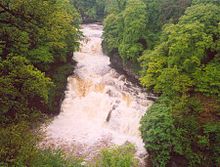- Falls of Clyde (waterfalls)
-
This article is about the group of waterfalls along the Clyde at New Lanark. For the Falls of Clyde nature reserve, part of the Clyde Valley Woodlands National Nature Reserve, see Falls of Clyde (nature reserve).
Falls of Clyde 
Corra Linn in full spateLocation  New Lanark, South Lanarkshire, Scotland
New Lanark, South Lanarkshire, ScotlandTotal height 62 m The Falls of Clyde is the collective name of four linn (Scots: waterfalls) on the River Clyde near New Lanark, South Lanarkshire, Scotland. The Falls of Clyde comprise the upper falls of Bonnington Linn, Corra Linn, Dundaff Linn, and the lower falls of Stonebyres Linn. Corra Linn is the highest, with a fall of 90 feet. Bonnington Linn (fall of 30 feet), Corra Linn and Dundaff Linn are above New Lanark and located within the Falls of Clyde Reserve managed by the Scottish Wildlife Trust, a national nature conservation charity. Stonebyres Linn is located several miles downstream from the reserve and New Lanark.
Contents
History
The area has long been a popular destination for visitors. The Wordsworths, Coleridge and Sir Walter Scott all visited the Falls. In 1802, William Wordsworth immortalised Corra Linn, the largest of the waterfalls, in verse. Corra Linn has also been painted by a number of artists, including J. M. W. Turner. The name comes from the Gaelic 'currach', a marshy place. A legend gives 'Cora' as a daughter of King Malcolm II, who lept to her death here whilst trying to escape imagined danger.[1]
Near Corra Linn is the Pavilion, built by Sir John Carmichael of Bonnington, probably in 1708. The Pavilion had mirrors on its back wall, and when the doors were opened visitors had the illusion of standing beneath the falls. The 15th century Corra Castle is next to Corra Linn. It is now home to a family of rare bats. Corehouse, built in 1844, the home of the Cranstoun family, is nearby.
Falls of Clyde Reserve
The reserve is an area of mixed woodland, including semi-natural native oakwoods and some areas of conifer plantation. It provides suitable habitat for badgers, roe deer, and over 100 species of bird. The site is well-known for its resident breeding pair of peregrine falcons, which are protected during the breeding season by Operation Peregrine, providing security for the birds and a chance for the public to view the birds through scopes and CCTV. On the 22nd October 2011 at 1500 GMT a very rare pine martin was spotted within the reserve and was photographed. The photos will appear here once they have been uploaded and approved approved. Within the reserve the Clyde River is suitable habitat for Otters and Kingfishers as well as the protected Brook Lamprey.
The Falls of Clyde Visitor Centre, operated by the Scottish Wildlife Trust, features exhibits about the waterfalls, the woodland and the area animals, including a special bat display.
Hydro-electric power
A hydro-electric power station is situated between Corra Linn and Dundaff Linn, with a water inlet at Bonnington Linn. This plant was built in 1927 and was the first hydro-electric power station in Scotland. It generates approximately eleven megawatts of power. Another hydro-electric power station is situated near Stonebyres Linn. This generates approximately six megawatts of power. Both stations are owned and operated by Scottish Power. The station's water draw off means that the waterfalls are not always in full spate, but agreed 'Waterfall Days' allow visitors to see them in their natural state.
Clyde Walkway
The Clyde walkway long distance path passes all four falls and ends at Bonnington Linn.
Photograph gallery
See also
- Lanark
- Bonnington pavilion, Falls of Clyde
Maps
Annotated map of Lanark, New Lanark and Falls of Clyde
References
- ^ Westwood, Jennifer and Kingshill, Jennifer (2009). The Lore of Scotland. A Guide to Scottish Legends. London : Random House. ISBN 97819055211623. p. 176
Historical Tours in the Clyde Valley. Published by the Clyde Valley Tourist Association and the Lanark & District Archaeological Association. Printed by Robert MacLehose and Company Limited, Renfrew, Scotland. 1982.
External links
Coordinates: 55°39′16.85″N 3°46′17.37″W / 55.6546806°N 3.7714917°W
Categories:- Waterfalls of Scotland
- Sites of Special Scientific Interest in Clydesdale and South East Glasgow
- Inventory of Gardens and Designed Landscapes
- Nature centres in Scotland
- Protected areas of South Lanarkshire
Wikimedia Foundation. 2010.











